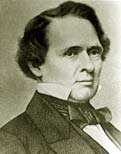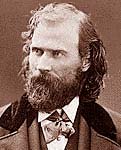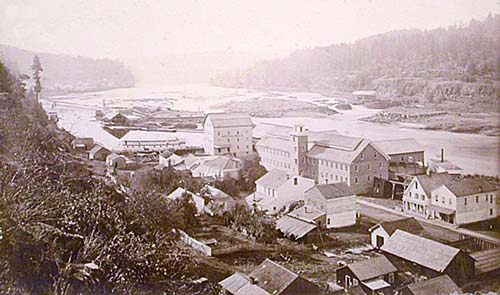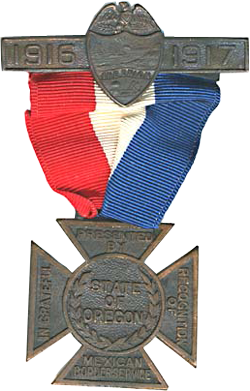Oregonians have fought in wars at home or in the far corners of the globe for much of the history of the state. In fact, numerous battles and skirmishes marred the provisional and territorial government periods before statehood in 1859.
Indian Wars
Native and immigrant Oregonians began fighting in the 1840s. Oregon's provisional government passed the first militia law in 1843. But no organized militia formed until the 1847 Cayuse Indian attack on the Whitman Mission in what is now southeastern Washington. The attack killed missionary Marcus Whitman, his wife, and 12 other whites. For weeks, 53 women and children were held captive.
Tragically, the event illustrated the clash of cultures between Native Americans and early settlers to Oregon Country. The Native Americans were increasingly hostile, fearing they would lose their land and way of life to the ever-growing numbers of whites. Tensions mounted when in 1847 an outbreak of measles ravaged the Cayuse people who lived near the Whitman mission. Whitman, both a missionary and a practicing physician, treated the sick but while white people seemed to recover, the Indian deaths continued. Finally, some of the Cayuse, acting on the belief the doctor was "bad medicine," decided to kill him in an attempt to put an end to the sickness.
 Gov. Joseph Lane
Gov. Joseph Lane The Oregon Militia soon mounted a campaign against the Cayuse to rescue the captives and bring the perpetrators to justice. Desertions and indecisive leadership marred the effort but finally, 29 months after the murders, Governor Joseph Lane secured the surrender of five members of the Cayuse tribe. The men were brought to Oregon City where they were tried in U.S. District Court in 1850. The jury returned guilty verdicts for all five of the accused who were soon publicly hanged.
The news of the Whitman Massacre spurred the U.S. Congress to create the Oregon Territory in 1848. Territorial status brought Oregon arms for its arsenals and federal troops to assist in fighting future battles with Indians. Later, the state constitution of 1857 made the governor commander in chief of the state's military and naval forces. It also allowed the governor to appoint the adjutant general who oversaw the related administrative and logistical functions. Sadly, the Indian Wars continued sporadically until the late 1870s. Numerous skirmishes were punctuated by the Rogue River War in 1855-1856, the Modoc Campaign of 1872-1873, and the Bannock War of 1878. By that time, nearly all of the Native Americans in Oregon had been forced onto reservations.

Editor Joachin Miller was labeled as a pro-southern.
Editor Joachin Miller was labeled as a pro-southern. Civil War
Because of its distance from battlefields largely located in the southeastern region of the U.S., Oregon was not strongly affected militarily by the Civil War. But the state did feel certain consequences. Early in the war, most federal troops in Oregon were moved elsewhere for war service. By the spring of 1861, only about 700 remained in the entire Pacific Northwest. Nervousness prevailed since just months earlier the Salmon Falls massacre had left only 15 survivors out of a party of 44 immigrants.
President Abraham Lincoln issued an appeal for volunteers to fight in the war, but Oregon Governor John Whiteaker sympathized with the South and failed to respond. Instead, he urged a neutral stance focused on defense only since the state was so far from the battles. Whiteaker was not alone in sympathizing with the Confederacy and some Oregon communities saw minor clashes between northern and southern sympathizers.
 Oregon City (shown in 1867) and the Willamette Valley drew many immigrants. The military protected their travels during the Civil War in the Northwest. (Carleton Watkins, Oregon Steamship Navigation Company Album, Oregon State Library)
Oregon City (shown in 1867) and the Willamette Valley drew many immigrants. The military protected their travels during the Civil War in the Northwest. (Carleton Watkins, Oregon Steamship Navigation Company Album, Oregon State Library) More typical was the experience of Joachin Miller, who would go on to be a famous poet and writer. Miller felt the tensions in one Willamette Valley community during the war. Following the Quaker beliefs of his father, Miller used his position as editor of the "Eugene City Democratic Register" newspaper in 1862 to plead for the end of the war. But his anti-war editorials were not well received and his paper was "promptly suppressed as pro-Southern in sympathy." After other similar results, Miller sold his paper, packed up, and left the area in search of more like-minded citizens.
Hundreds of Oregonians volunteered for military service during the Civil War. Most were used to police Indian tribes and provide escort duty for the thousands of immigrants who continued to stream to Oregon. The men served in Oregon as well as neighboring Washington and Idaho territories. For many soldiers stationed locally, the Civil War in Oregon brought nothing but monotony. Officers reported desertions, suicides, and soldiers thrown in the brig because of drunkenness and misbehavior. "Nothing transpired of importance," recorded one soldier at Fort Yamhill. Some enlisted under less than ideal circumstances. German born laborer George Schaffer signed up in Salem as a private after he was convicted of forgery and sent to the penitentiary. Others, such as Private A.D. Larkin of "E" Company 1st Infantry, were "rejected and discharged by reason of unfitness for service." Overall, the contrast with the main theater of the Civil War could not have been more stark.
 Brevet Brigadier General Owen Summers commanded Oregon soldiers in the Philippines. (OSA, Oregon in the Philippines, compiled by C. U. Gantenbein, 1903)
Brevet Brigadier General Owen Summers commanded Oregon soldiers in the Philippines. (OSA, Oregon in the Philippines, compiled by C. U. Gantenbein, 1903) Other Service Before World War I
Later, many Oregonians served during the Spanish-American War, particularly in the Philippine Islands. After President William McKinley called for volunteers in April 1898, Oregon mustered a complete regiment of infantry, designated the Second Oregon. The regiment mobilized at Irvington Park in Portland, which took the name Camp McKinley. There it trained under Colonel Owen Summers until it was ordered to San Francisco for departure to the Philippines on May 25, 1898. Oregon troops participated in several engagements, including the occupation of Manila. The soldiers stayed on after the Spanish surrender to serve during the prolonged Philippine insurrection, including the battle of Malabon in March 1899. Over 1,600 Oregonians served in the fighting. Of these, 13 were killed in action, four died of wounds, three were missing in action, and two died from accidents. Disease claimed the lives of 43 Oregonians and 84 suffered wounds in action.
 Mexican border service medal. (OSA, Military Dept. Records)
Mexican border service medal. (OSA, Military Dept. Records)
In 1916 and 1917 Oregon National Guard soldiers saw service along the Mexican border as the United States mounted an armed expedition to Mexico to end raids into U.S. territory by Mexican leader Pancho Villa. An Oregon National Guard recruitment card extolled the service as an opportunity of a lifetime. Recruits could get military training under "real war conditions, with the minimum of personal danger." Oregon men from 18 to 45 years of age qualified for service. They would earn from $15 to $45 per month "with all the necessities of life furnished, including medical attention - the pay is for your luxuries...." The reader was encouraged to "look this card over, but don't over look it." After all, "you will get a free trip of nearly 2000 miles to Southern California." Who could resist?
General John J. "Blackjack" Pershing led American forces before drawing the assignment of building the American Expeditionary Force in preparation for the American entry into World War I the next year. The Mexican border duty consisted of constant patrols and drilling but led to no real action for the Oregon troops. However, officials credited their service along the border as having "effectively restrained Mexican raiders from action against American ranches and settlements."
Notes
(Dictionary of Oregon History, Howard Corning, ed., 1956; Historical Annual National Guard State of Oregon, 1939; Oregon Soldiers During the Civil War, Genealogical Forum of Portland, Oregon, Inc., 1961; Oregon Blue Book, History section; Oregon in the Philippines, compiled by C.U. Gantenbein, 1903; Oregon Military Department Records, Ephemera, recruitment card; Photographs and Service Medals)